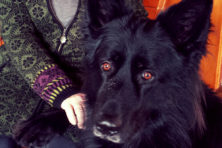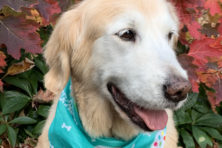The Story of a Therapy Dog
- Share
- Tweet
- Pin
- Share
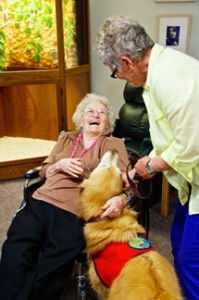
If at first you don’t succeed, try, try, again was the motto of therapy dog Amos.
The first time he took his certification test, he was a little rambuctious and flunked. But after following the advice of the trainer to wait until he had settled down a bit before retaking the exam, he passed on his second attempt with flying colors.
Now at the age of seven, the golden retriever Amos is an experienced therapy dog with a red work vest and an official certificate.
Gloria Dougherty was a cardiac specialist nurse for 30 years in Lake Bluff, Ill., and then worked in a bookstore. When in 2006 she and her husband moved for their retirement to Cottage Glen, Ellison Bay, her life-long affection for dogs, her career of care-giving, and her love of books converged in a retirement project: Amos, a therapy dog.
After seeing news accounts of therapy dogs, she became inspired, especially by those animals that served as reading dogs in the children’s section of public libraries. “Reading” dogs, of course, have not mastered the art of literacy. But they are happy to be on the receiving end of the emerging reading skills of boys and girls who bring favorite books to the library and take turns reading out loud, offering the unconditional affection of a willing listener who is both appreciative and non-judgmental.
Amos’s path toward becoming a therapy dog began with two years of obedience training followed by the four-week therapy course then offered by Birchwood Kennels in Sturgeon Bay. A part of the training involved familiarizing the dog with crutches, wheelchairs, and people walking slowly, Dougherty explained. After the disappointment of his first exam, “He tested again at the kennel, at Door County Hospital, at a nursing home, and in the park, and passed,” she said.
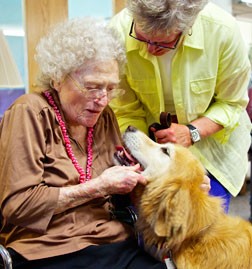
While originally she intended him to be a reading dog, she saw he conducted himself well with older people at the nursing home during his test, and noticed how much they liked him. “And then I went to Scand with him,” she said.
For two and a half years she has been taking him to the Care Center and Woodview Assisted Living at Scandia Village once each week. “He is so sweet with people!” she said. In particular, “He became close friends with [the late] Lee Traven, who had had a golden retriever but no longer could have a dog of his own.” When Traven passed away, Dougherty took Amos to the memorial service.
She and Amos have become close to a number of people at Scandia. “I am at the other end of the leash!” she said. “People who had dogs in the past – I hear a lot of stories about dogs.” Some who are not dog people watch from afar. But often even those people become involved in a game of table ball in the activity room when “Amos will put his paws on the table and take turns pushing the ball with his snout.”
Now Dougherty and Amos divide their time between Scandia Village and the Sister Bay/Liberty Grove Library. “He’s a good reading dog,” Dougherty said, “but Scand is where he really does his good; he let’s people connect with him, they pet him, and I wait. I have no agenda. And it’s good therapy for the workers as well.”

The Sturgeon Bay library had three reading dogs in a their therapy dog program. When she and her husband watched them at work, “I knew Amos could do that, too,” she said, “and approached Betty Curzon” at the library in Sister Bay. She is now in her second year with the program at that library, where people bring their children and grandchildren to read to Amos.
Dressed for work in his red vest each Thursday summer morning beginning at 10:30, Amos lies on a quilt with his mistress beside him and listens to children who kneel close to him reading from a favorite book. Names are placed on a sign-up list ahead of time, and each child reads for about five minutes. During the school year Amos visits the library once each month.
“I’m not going to teach them to read,” Dougherty explains, “but they are just enjoying reading to the dog. I’m showing them the fun.”
Amos doesn’t care if they don’t know a word, she said, and if they make a mistake, she doesn’t correct them. But she has found that often if a child stumbles over a word twice, many times on the third try, without correction, the word is read correctly.
To make the reading experience even more memorable, Dougherty shows Amos’s appreciation to young readers by giving them baseball-style cards with pictures of the dog, as well as his “stats,” his likes and dislikes, and even his secret fears (vacuum cleaners).
Dougherty has learned of a program that trains therapy dogs to be reading education assistance dogs in schools, and intends to send Amos back to school to broaden his certification with a target graduation date of next summer.
“I get a lot out of this,” she said.
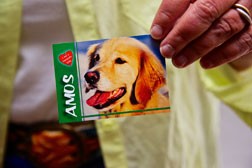
Not only does Dougherty get to see young readers gaining confidence and increasing their reading skills, but “the same is true at Scand,” she said.
“It’s been a good hour,” she said, when Amos produces “a laugh or a good smile” from someone. “It’s a way of connecting.”
Share Amos’s experience by checking out Dougherty’s picture book Amos, the Therapy Dog (dedicated to Lee Traven) at the Sister Bay/Liberty Grove Library. To learn more about the certification Amos has completed, visit therapydogs.com/Public/Home; for the education assistance program, therapyanimals.org/R.E.A.D.

